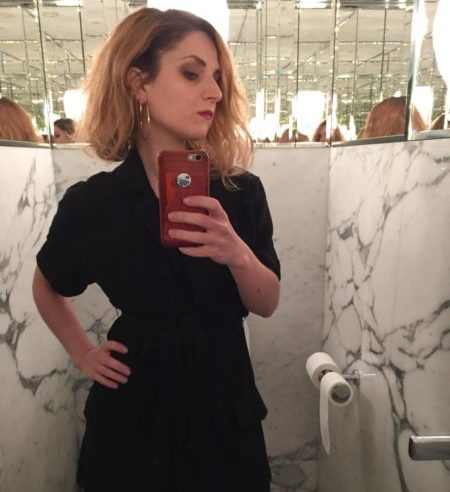Search
To search for an exact match, type the word or phrase you want in quotation marks.
A*DESK has been offering since 2002 contents about criticism and contemporary art. A*DESK has become consolidated thanks to all those who have believed in the project, all those who have followed us, debating, participating and collaborating. Many people have collaborated with A*DESK, and continue to do so. Their efforts, knowledge and belief in the project are what make it grow internationally. At A*DESK we have also generated work for over one hundred professionals in culture, from small collaborations with reviews and classes, to more prolonged and intense collaborations.
At A*DESK we believe in the need for free and universal access to culture and knowledge. We want to carry on being independent, remaining open to more ideas and opinions. If you believe in A*DESK, we need your backing to be able to continue. You can now participate in the project by supporting it. You can choose how much you want to contribute to the project.
You can decide how much you want to bring to the project.

1.The artist is an impostor.
2.Pardon?
1.An individual who deceives the world from his loneliness. Someone who introduces a piece of fiction into a space reserved for reality. Play invades ordinary life.
2.The Dutch call the still life betriegerje (a small deception).
1.Although in this case the frame isolates the painting, it is a fracture between the two planes: the real and the fictitious. The impostor is he who is able to remove the frame, making inside and outside collide. The collision contains a violence that shakes us, that affects us. That enchants us.
2.Who are you thinking of?
1.Of all the apologists of fraud and suspect storytellers. Orson Welles, Philip K. Dick, Amalia Ulman. Welles confusing radio listeners with an intergalactic invasion or manipulating viewers with a (fake?) documentary featuring (the forger?) Elmyr de Hory and his biographer, (another forger?) Clifford Irving.[1] Or, Philip K. Dick and his characters, who are always trapped in a semi-reality.[2] As in The Great Pretenders by Lope de Vega, life and the stage are fused and the actor becomes a martyr. The same goes for Amalia Ulman and her performance for Instagram.[3] According to Vitruvius, Agatharchus was the first impostor-artist. In the 5th century BC, his stage designs for a tragedy by Aeschylus caused quite a stir. There was no continuity in his sets: the real and the fictitious were fused, so that – I quote from memory – ‘the images of buildings in painted scenes might have the appearance of reality’. His design was so revolutionary that it rekindled a huge controversy in which even geometricians and philosophers like Democritus and Anaxagoras took part. Have you been to Pompeii? That’s what I mean.
2.I see … feigned space and the space occupied by the viewer converge and merge.
1.Exactly, the two planes are superimposed in imposture. And this is where their disruptive power lies: totally eluding the limits between the real and the invented, the novelesque, the fictionalised. This is therefore an exercise in transgression, in misappropriation, occupation, impersonation; an artifice that opens up a vertiginous gap. The impostor-artist creates appearances, ‘appearances of’. He always refers to something that isn’t there, but what truly matters isn’t appearance or absence but the disintegration of the two planes.
2.So do you think that artists succeed when they deceive us?
1.Well, we’re facing a paradox. The impostor-artist is a tragic anti-hero doomed to failure: if he manages to deceive us all, no one will know of his accomplishment. When Zeuxis reveals that his curtains are painted, not ‘real’, he is telling us that their value resides in their ability to prove that they’re not what they appear to be. If we’re unable to verify that everything is mere artifice, there is no astonishment. And in art there has to be wonder. Not an entrancing, hypnotic wonder of course, but rather a shock. You know — touché.
First of all, the trick, the farce, the simulation, the deception, the fraud. Then, the revelation, and in this exposure we discover another astonished gaze. The spectator is seduced, as is the leading character in the book that Marguerite Duras never wrote, a promiscuous novelist who lies about all possible trifles and loves fleetingly.[4]Artists cater to our fantasies and take advantage of our desires. They make us fall in love with people who don’t exist and yet we thank them for having made us dream, for a few moments, of other possible worlds.
Someone enters the exhibition hall, now transformed into a mattress shop: posters that promise a good night’s sleep, labels that announce a discount of up to 50%, and mattresses: viscoeslastic and latex mattresses, anti-allergy and reversible mattresses for summer and winter, mattresses measuring 80 x 180 cm and others measuring 150 x 180 cm, king size and queen size mattresses. Mattress bases too, wooden and metallic bases, reclining bases …
2.My question is why? Why lie? Why risk everything in a fiction?
1.There is a purpose, over and above practical reason. I would say there is a playful impulse,[5] compulsive even, which comes from deep down, from our unconscious, from our schizoid personality. Impostors appropriate themselves of things that don’t belong to them. They are slightly arrogant, somewhat vain and narcissistic. They try to draw attention to themselves in the hope of being loved, but above all, they are pervaded by a puerile pathos and ethos, for they are not aware of the impossibility. Or else they are aware of it but take no notice. They’re able to have double thoughts, like the child who suspects that carpets don’t fly but even so rub the magic lamp to make a wish.
2.But not all artists are impostors.
1.True. The impostor-artist is the profane and profaning artist. Opposed to the artisan-artist, the documentalist-artist, the auteur-artist. He isn’t interested in evidence but in supplantation. This is what distinguishes Velázquez from the rest of court painters. Breathless from other gangster films. Ready-mades from ordinary objects.
A painter who seems to be portraying us.
A character who questions us directly.
A urinal that says it’s a fountain.
Someone who tells us: this is artifice.
2.I think that montage, mise en scène and movement direction are required in order for imposture to work. Art can be driven by a centripetal force, to and from itself. If you’re close, you’re caught up in it; if you’re far away, you’re repelled by it. Other forces move parallel to the viewer — something moves but you can watch it with no fear of being touched by it. I’m speaking of a perpendicular movement that could have the force to penetrate you. You’re inside it, and it’s inside you.
1.But above all it needs someone to create. The artist proudly shows us his wound. A vibrant, bubbling, soft opening. He invites us to touch it. And as soon as our finger comes into contact with the fissure we realise that there is no cut and no body. Everything is artifice, a game of illusions. We reach out to touch the mirage but even so it doesn’t disappear … The impossible occurs. And miracles always need witnesses, or better still, believers.
2.You mean faith?
1.And magic. Agamben[6] recalls that Walter Benjamin once said that a child’s first experience of the world isn’t that adults are stronger, but that they are incapable of making magic. Isn’t the impostor someone who still believes in magic? Someone for whom everything is possible?
2.Exactly, the artist and the impostor couldn’t exist without one another; they are one and the same, people who risk everything for a fiction, people for whom worldly life is at once a playing field and a battlefield. Both share the same element of fantasy and rely on deceptions and false tales to create their cosmogonies. They are resourceful, inventive, seductive, and use all sorts of tricks and ruses to tell stories in which we are willing to believe. It all starts from a free and limitless impulse that turns into a phenomenon of excess and veiled self-representation. Funambulists, always walking on thin ice, always hovering over an abyss.
3.Excuse me, but I couldn’t avoid overhearing your conversation. The artist and the impostor are those who make us realise that reality is only a trompe-l’oeil. Look around you and tell me, what do you see?
THE END
*This is one of the ‘transformative installations’ by Belgian artist Guillame Bijl (Antwerp, 1946), in which he introduces a ‘reality’ in a ‘non-reality’, managing to move a socially or financially feasible organisation (at other times a casino, a launderette, a psychiatric hospital or an air-raid shelter), to an artistic context. http://www.guillaumebijl.be
[1] We are referring to F for Fake (1973). Suffice it to quote the introduction: ‘Ladies and gentleman, by way of introduction, this is a film about trickery and fraud, about lies. Tell it by the fireside or in a marketplace or in a movie, almost any story is almost certainly some kind of lie. But not this time. No, this is a promise. During the next hour, everything you’ll hear from us is really true and based on solid facts.’
[2] ‘Often people claim to remember past lives. I claim to remember a different, very different, present life.’ Statement made by Philip K. Dick at the Second International Festival of Science Fiction at Metz (France), 24 September 1977. As to his writings, we could mention Do Androids Dream of Electric Sheep? (1968), Ubik (1969), Flow My Tears, the Policeman Said (1974) or The Transmigration of Timothy Archer (1981).
[3] Entitled Excellences and Perfections, the project lay at the intersection of art and (digital) life and was developed over the course of 2014. During six months, Ulman (Buenos Aires, 1986) captivated her followers with publications that appeared almost on a daily basis: manicures, luxury hotels, healthy breakfasts, a wounded heart and even a plastic surgery operation. The truth: it was all lies. Along the same lines we find Privilege, where authenticity responds to class and gender privileges, to semi-fictional identities. More details at #amaliaulman
[4] Marguerite Duras, ‘The Man Who Was A Lie’, in Practicalities, translated from the French by Barbara Bray, Grove Press, New York, 1993.
[5] For Huizinga, play ‘is a voluntary activity or occupation executed within certain fixed limits of time and place, according to rules freely accepted but absolutely binding, having its aim in itself and accompanied by a feeling of tension, joy and the consciousness that it is “different” from “ordinary life”.’ In the sense that play has a fictitious, unproductive quality that entails an evasion from everyday or ordinary life. Johan Huizinga, Homo Ludens: A Study of the Play-Element in Culture, Angelico Press, Kettering, Ohio, 2016.
[6] Giorgio Agamben, Profanations, translated by Jeff Fort, Zone Books, New York, 2007.
(Featured image: Exhibition by Guillaume Bijl, curated by Frederic Montornés in ADN Platform, 2017. Photograph by Roberto Ruiz)

Gisela Chillida (Barcelona, 1987) is an art critic, independent curator and cultural manager. She writes regularly for the magazines and publications Bonart, Hänsel i Gretel, Núvol-Digital de Cultura, La Maleta de Portbou, Politica&Prosa and Diario Levante. Recently, he has published the book “Galeries d’art a Catalunya” and the catalogue of the exhibition “Tàpies/Alcaraz/Rubert” at Kunst Lager Haas in Berlin. Some of her exhibitions as a curator have been shown in the galleries Àngels Barcelona (Enésima Intempestiva), Arte Aurora (El pliegue y Seastanding) and Àcid Sulfúric (Europolis), the space Cera 13 (Luna y polvo) or in Fase Espacio de Creación y Pensamiento. Since 2018, she coordinates the Loop Discover Award, held within the framework of the LOOP Barcelona video art festival and fair.
"A desk is a dangerous place from which to watch the world" (John Le Carré)